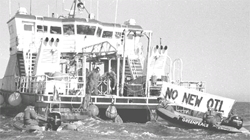Seas of despair
 toxic wastes are leaching into the North Sea from piles of debris heaped up beneath oil rigs, reports a new survey. Levels of heavy metals dissolved in water immediately above the dumps exceed environmental safety limits, say scientists at the Dunstaffnage Marine Laboratory near Oban, Scotland. Their effects on marine life is yet to be assesed. Drilling for oil has left seven million cubic metres of cuttings, including metals, lubricants and rock, beneath some 1,500 North Sea oil rigs. For the past two years European governments have been trying to decide how to tackle this waste crisis.
toxic wastes are leaching into the North Sea from piles of debris heaped up beneath oil rigs, reports a new survey. Levels of heavy metals dissolved in water immediately above the dumps exceed environmental safety limits, say scientists at the Dunstaffnage Marine Laboratory near Oban, Scotland. Their effects on marine life is yet to be assesed. Drilling for oil has left seven million cubic metres of cuttings, including metals, lubricants and rock, beneath some 1,500 North Sea oil rigs. For the past two years European governments have been trying to decide how to tackle this waste crisis.
Until now, scientists assumed that metals would remain trapped within the piles. But a study managed by Britain's National Environment Research Council and the oil industry has found high levels metals in water around the cuttings piles at two wells operated by the us oil company Amoco. Levels of arsenic and nickel in the seawater above piles at the wells Northwest Hutton and Wellhead 1523b exceeded British environmental quality standards. These limit the concentration of arsenic in seawater to 25 parts per billion (ppb) and that of nickel to 30 ppb. At Wellhead 1523b, arsenic and nickel concentrations were estimated to be 38 ppb and 44 ppb respectively.
Concentration of metals were even higher in water samples taken from pores within the cuttings piles, reaching 90 ppb for arsenic and 70 ppb for nickel. The study's authors, Eric Breuer and Graham Shimmield of the Dunstaffnage Laboratory, argue that other cuttings piles under other North Sea rigs are also likely to be leaking.
"We have discovered something unexpected,' says Breuer. "These are not dormant piles of sediment. They are quite volatile.' He calls for further investigations to find out if toxic leakage is harming marine life. In June 1998, the uk Offshore Operators Association ( ukooa ) launched a two-year research programme to determine what exactly should done with the piles. At a seminar in London in January this year, the Norwegian consulting firm, Rogaland Research, came up with seven options. These include dredging the cuttings piles on the surface, reinjecting them into the wells, covering them with gravel and simply doing nothing. If the waste piles are left untouched, they will go no leaching toxic waste. But the attempting to move the piles with existing technologies might release more heavy metals into the water. "This is a complex issue,' says Eric Faulds, the chairperson of the ukooa 's task force of cuttings piles. "If there is any certain outcome, it is that there will be no best option.'
